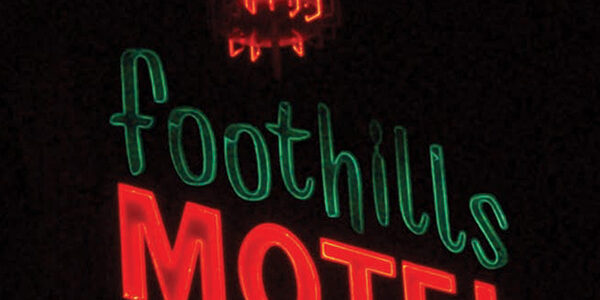Thar’s Gold in them Foothills! What a motel can reveal about postwar America.
A year ago a brother-in-law mentioned he would be helping to rehab a motel in Auburn, California, not far from where I live. Although we didn’t exchange details of time and place, I knew it would not be difficult to find him: Auburn had few motels and the only one I assumed would need new wallpaper was easy to locate. I had often driven past the Foothills Motel, though its long entrance did not lend itself easily to inspection. The long curving driveway that led up to the motel had kept me from ever entirely seeing the structure itself. So for the first time, I followed the neon arrow directions to the crest of the motel property and was taken aback as I passed beneath the extensive carport. Nothing had changed on the property in 50 years. That long driveway just might have contributed to its untouched appearance and intact survival into the 21st century.
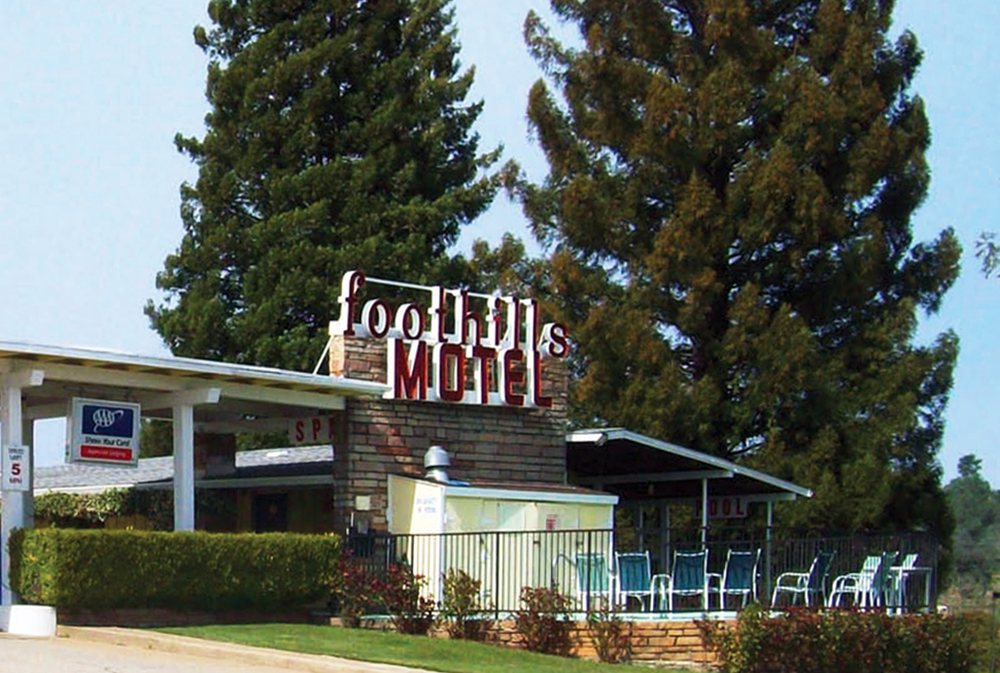
The U.S. Highway 40 Effect
Auburn’s location lent itself well to the service industry. The town began early in California’s history, barely 12 miles from Marshall’s 1848 gold discovery in the town of Coloma and a source of mining activity in its own right. Later, Auburn’s location as a halfway point between San Francisco and Lake Tahoe required the continuous building of reliable roads impervious to the weather of the Sierra Nevada Mountains. Frequent expansions to the auto trails and the highways that followed happened almost every 20 years to serve these fashionable destinations.
The Foothills Motel was built in 1955 along U.S. 40. One of the original 1926 federal highways, Route 40 ran from New Jersey to San Francisco. Much of the route began as an auto trail known as the “Victory Highway,” named for the military success of World War I. An even earlier auto trail, the Lincoln Highway, was established in 1913. The Lincoln and U.S. 40 often paralleled and sometimes briefly merged with each other throughout California. They certainly did through Auburn. Remnants of each highway remain and are historically marked within walking distance of the motel.
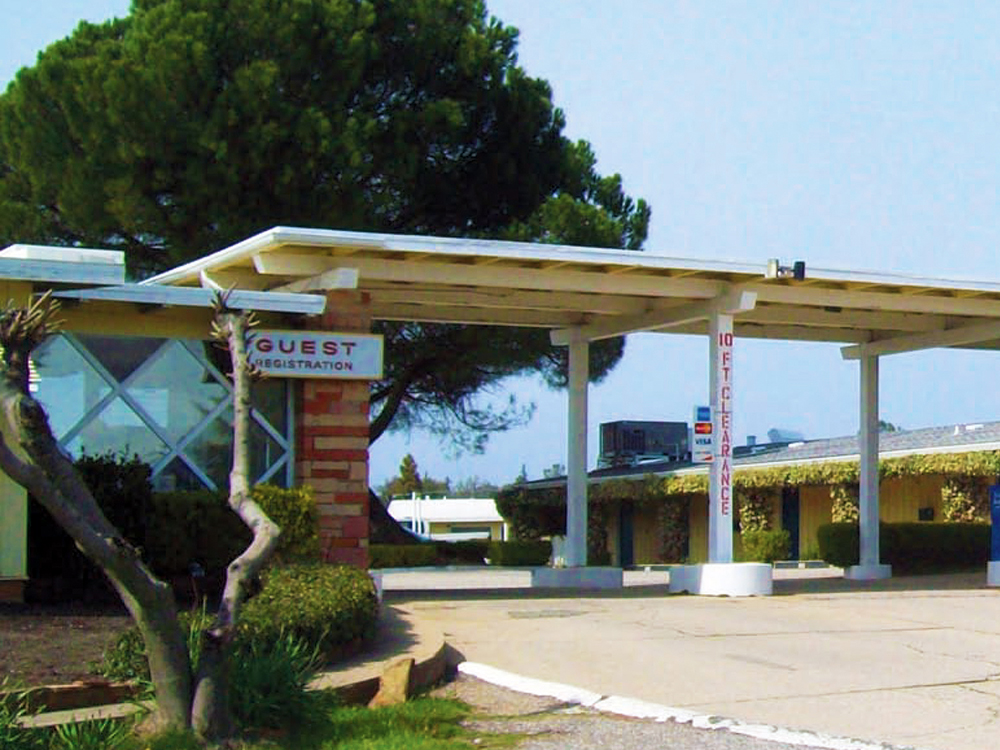
Post-War Highway Transformations
U.S. 40 was designated a national defense highway in 1940 and federal funds fueled improvements. The projects saw many residences and businesses along the route destroyed or diminished. In 1946 work to enlarge U.S. 40 to four lanes through Auburn, California, was started and by November 15, 1947, the freeway was officially open.1 However, by mid-century the highways spanning the country were proving inadequate to carry the quickly expanding number of cars and drivers. This growth in travel was fueled by an affluent and growing population, and propelled by a cost of living that doubled every 10 years. This growth, combined with a presidential emphasis stressing the need for national security, secured the passage of the Federal Highway Act of 1956. More improvements followed but by 1964, Highway 40 had been decommissioned by California, replaced (often literally) by Interstate 80. Within 12 years the project was complete— meandering Highway 40 was often simply converted to I-80. The Interstate greatly widened the Highway 40 corridor so that the few businesses and residences previously untouched by Highway 40 now fell under the wide swath of the Interstate. This new superhighway passed within 500 feet of the Foothills Motel but that at least guaranteed that drivers would see the place.
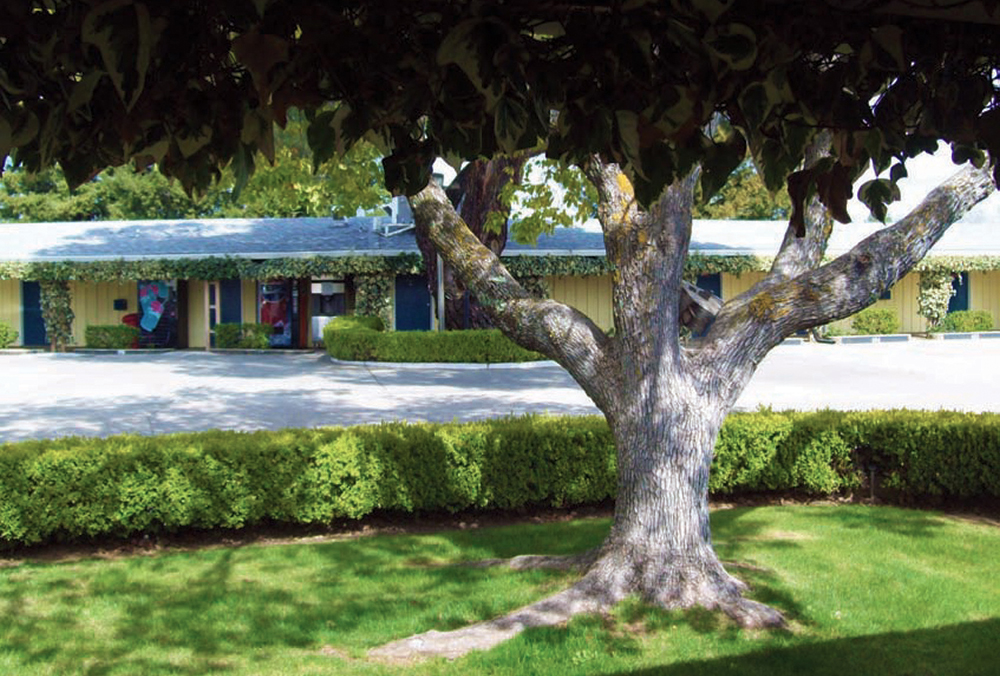
The Foothills Motel avoided demolition by its physical location. Not only was it centered upon a parcel exceeding four acres, it was deliberately situated on a gentle hill overlooking the Sierra Nevada mountains to the east. The lengthy drive to reach the carport entrance alone saved the motel from eminent domain threats by guaranteeing extensive frontage between it and any highway expansions. Not even this behemoth of transcontinental freeways came close enough to encroach upon the motel.
A Complete Roadside Retreat
The Foothills Motel was conceived in 1954 when the Train Development Company filed papers of incorporation. Construction began in January 1955 just east of Auburn on land owned by Auburn residents Patrick and Dolores Train. By July 14, the motel was open for inspection by local residents during the day and for travelers along Highway 40 in the evening.2 During the motel’s grand opening the public could also inspect the Train Village subdivision located just north of the motel that contained 34 homes that required no down payment from veterans.
The Trains also developed the Foothills Bowling Alley and owned the Union 76 gas station across from the motel which, when combined with the motel, restaurant, and housing tract, comprised the corporation known as Train and Company. This mid-century plan was a self-contained roadside oasis perfect for families or individuals and for travelers or local residents. Although not a destination in itself, it provided a pleasant source of comfort and recreation entirely within a 10-acre area. Travelers stopping at the motel for the night were encouraged to eat at The Ground Cow restaurant next door and then visit the adjoining bowling alley before retiring for the night, and of course fuel and service were conveniently available too.
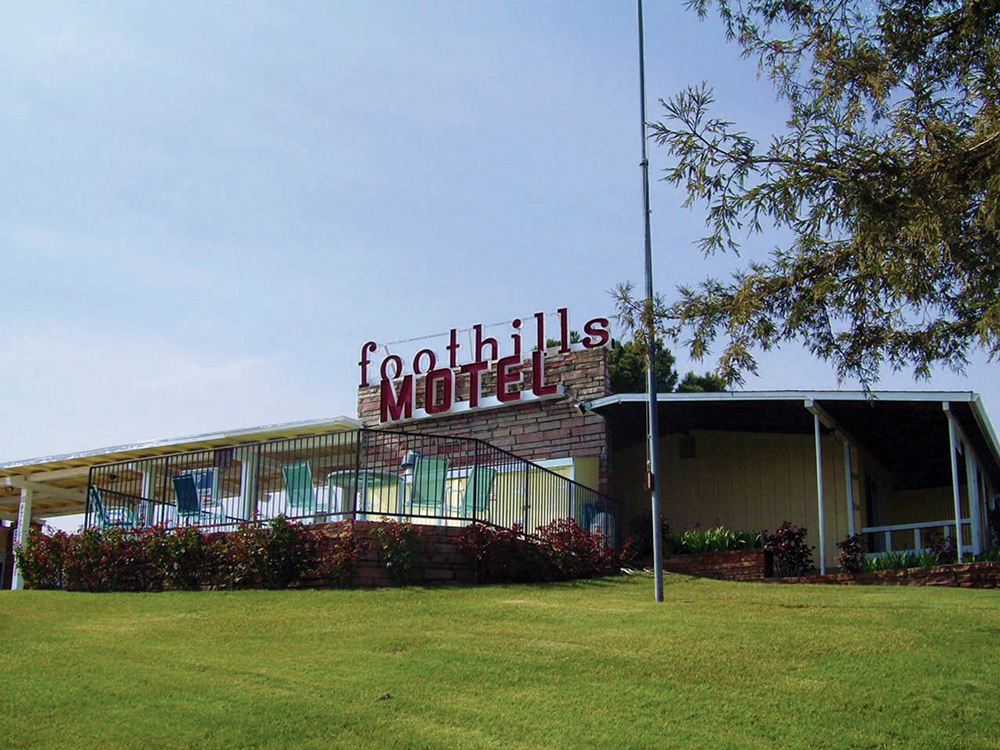
This post-war concept of entertainment, leisure, and culture had evolved into something not seen before in American life. At the turn of the 20th century, recreation and culture, especially popular culture, came to the family. People stayed in their town or city and enjoyed books, plays, and the circus as well as religious camp revivals and lecture circuits. It wasn’t necessary to travel in order to experience or enjoy such things; culture was brought to them.
Now, only a few decades later, families and individuals sought cultural experiences by leaving home and town. For the first time average Americans could choose their own diversions and seek out their own interests over considerable distances. The highway system facilitated this and, in itself, became a destination.
Auto camping in tents or cottages had evolved into comfortable air-conditioned motels with swimming pools. Restaurants were plentiful and gasoline was inexpensive; stations competed for customers with loyalty stamps and dishware. The Foothills Motel complex exemplified the major shift in the middle-class pursuit of recreation and leisure.
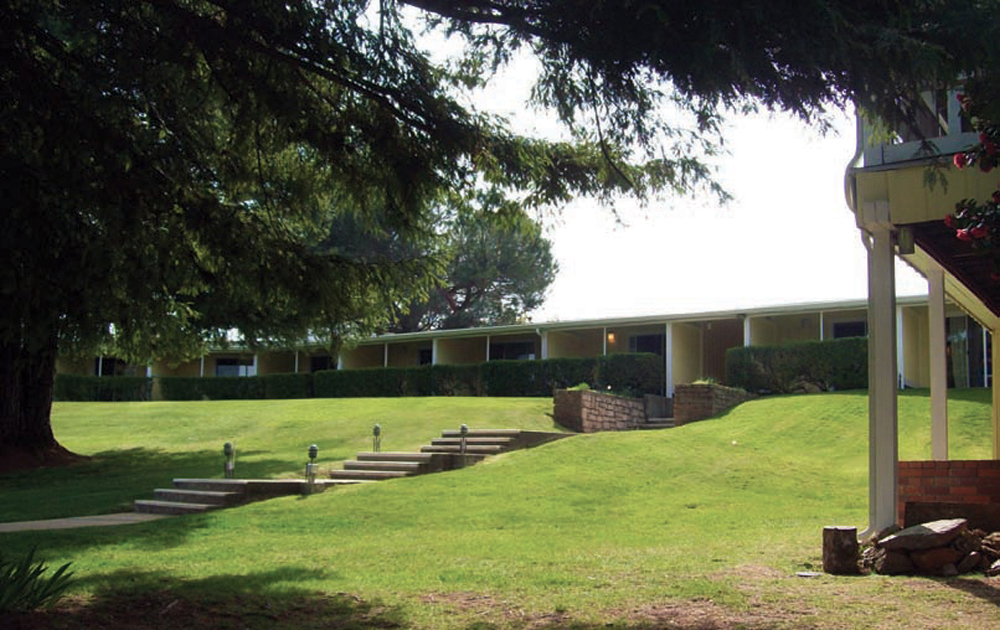
Cold-War Boosterism
The July 14, 1955, issue of the Auburn Journal and Placer County Republican featured eight pages of articles and congratulatory ads welcoming the new Foothills Motel to Auburn. Merchants hailed the construction as an “ultra modern addition to the community of Auburn [that] will advertise the progressive spirit of the people of this area to thousands of tourists each year and afford them an unexcelled view of our unexcelled mountains.”3
Mid-century boasting, lingering from the era of Western expansion, emphasized economic growth, business foresight, and a more modern community. Local pride was referenced by dozens of Auburn businesses and their advertisements which flanked the newspaper articles regarding the motel. A full page advertisement endorsed by dozens of community merchants gushed:
THIS BEAUTIFUL NEW ADDITION TO OUR COMMUNITY IS OUTSTANDING FOR ITS KIND BETWEEN SAN FRANCISCO AND RENO. WE ARE PROUD OF THE BUSINESSMEN WITH FORESIGHT AND ABILITY TO BRING TRAIN VILLAGE AND THE FOOTHILLS MOTEL TO OUR AREA. THE 60 REFRIGERATED AIR CONDITIONED UNITS, COMPLETE WITH TELEVISION FOR EACH UNIT OFFERS THE FINEST ACCOMMODATIONS TO THE TRAVELING PUBLIC AND AN UNEXCELLED VIEW OF THE AMERICAN RIVER CANYON AND THE SIERRA NEVADA MOUNTAINS.4
In response to the newspapers queries, Pat Train listed the technological developments and modern surroundings reflecting the new scientific innovations and aesthetic values of the Cold War era. In these interviews he promoted the facility as being “modern in every respect with a refrigerant type air conditioning, connected to a 24-hour switchboard, wall to wall carpeting, tile baths and the latest in motel comforts.”5
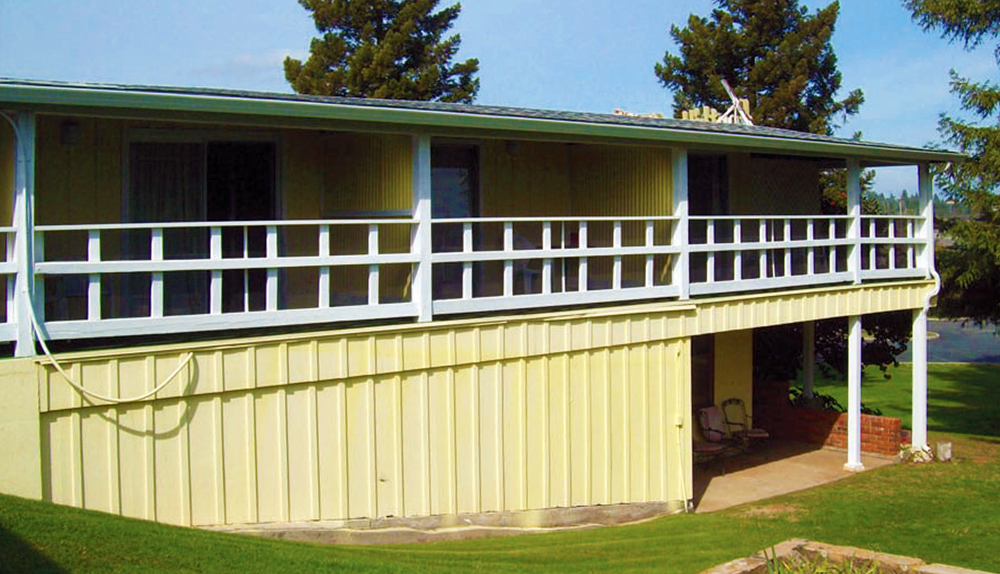
Architectural Eclecticism
The motel’s design unashamedly catered to the new automobile culture created by the exceptional level of prosperity enjoyed during the 1950s. The Foothills Motel features large sheet glass windows both in the front of the motel rooms and in the back of the deluxe rooms in the form of sliding glass doors. These windows overlook not only the Sierra Nevadas but, more importantly, Highway 40.
The large windows also advertised modern accommodations to passing drivers much as an animated billboard might. Additionally, large panoramic windows allowed occupants to be in close proximity to their new and very large automobiles. As car travel and disposable income combined to create an entirely new area of commerce, this innovative property type reflected the lifestyle of the rapidly changing popular culture of the mid-twentieth century.
The Foothills Motel alone covers 4.4 acres, most of which is parking, an essential part of the post-war commercial landscape. The four motel units sprawl toward the outer edges of the property, deliberately showcasing a huge central expanse of blacktop for parking, turning and driving. A large white carport anchors the entrance of the motel and another repeats the pattern as one drives toward the rear of the motel where more parking awaits.
To encourage business, the Foothills Motel erected four different neon signs, all in Doo Wop style to attract the public with a Space-Age flamboyancy. Mid-century flowing script, vertically striped spinning barrels, starbursts, and boomerang shapes on high reader signposts caught the attention of motorists.
The motel itself does not follow archetypical Doo Wop architecture. Although the entrance conveys a minimalist, international modern style, the units themselves are of the Ranch style that dominated residential home construction in the 1950s and ’60s. Although decorative elements are minimal, the wide, overhanging eaves traced with ivy growth mimicked the comfort and security of home.

In contrast, Doo Wop signage advertised entertainment and recreation in a modern vacation setting. The design perfectly revealed the characteristics and uniqueness of America as it behaved during the middle of the twentieth-century: optimistic, young and prosperous. Their parents had not known this lifestyle and neither would their grandchildren. It was the American decade within the American century. Occasionally one is fortunate enough to find those remaining resources that reveal the spirit of our distinctive national character of a half century ago—a time of endless consumerism and global dominance.
The frontage road that accessed this development was known as Train Village Road until the 1970s when the name was changed to Bowman Road. By 1982, out-of-town investors had purchased the commercial properties of the Train Development Company including the motel.6 Much of the panoramic view of the Sierra Nevada range from the motel has been obscured by development along the old Lincoln Highway route. Of the many former Highway 40 motels built between Sacramento and Auburn in the post-war years, only the Foothills Motel preserved its original historic fabric and design. The rest have been demolished by expansion, reduced by freeway encroachment or are no longer maintained in their primary purpose. Only the motel and bowling alley retain their original intent as to commercial use.
As it happened, I never found my brother-in-law that week. I later learned that he had been replacing wallpaper at a national chain motel which had, four years earlier, franchised one of its corporate replicas in Auburn adjacent to Interstate 80. Thank goodness.
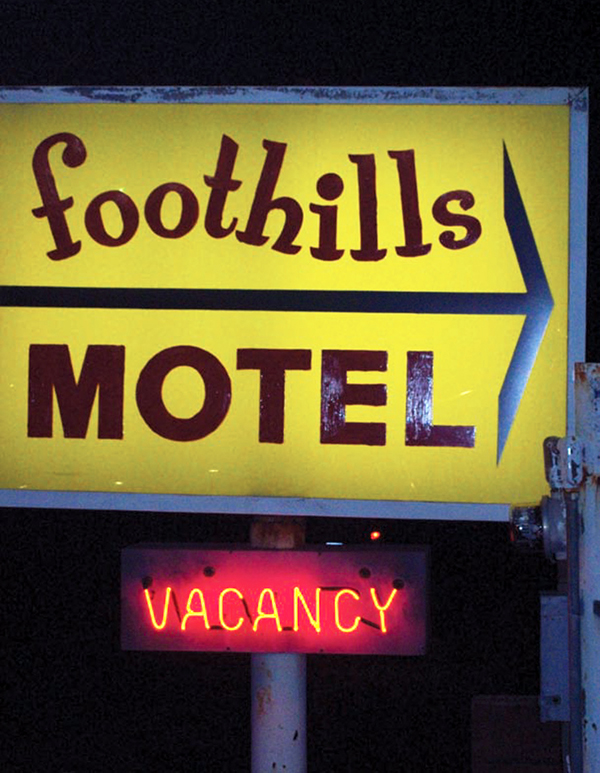
About the Author: Michelle Balaguy is a graduate student in history and lives with her three sons in the Sierra Nevada foothills. Her emphasis is in the American West.
Endnotes
1 “New Freeway Officially Open,” The Placer Herald, 15 November 1947.
2 “Foothills Motel To Hold Grand Opening Friday,” Auburn Journal and Placer County Republican, 14 July 1955.
3 Placer County Bank advertisement, Auburn Journal and Placer County Republican, 14 July 1955, sec. 2.
4 Ibid.
5 “Foothills Motel To Hold Grand Opening Friday,” Auburn Journal and Placer County Republican, 14 July 1955.
6 Placer County Assessor’s Office, Auburn California. Building Permit.
Did you enjoy this article? Join the SCA and get full access to all the content on this site. This article originally appeared in the SCA Journal, Spring 2010, Vol. 28, No. 1. The SCA Journal is a semi-annual publication and a member benefit of the Society for Commercial Archeology.
More Articles Join the SCA


